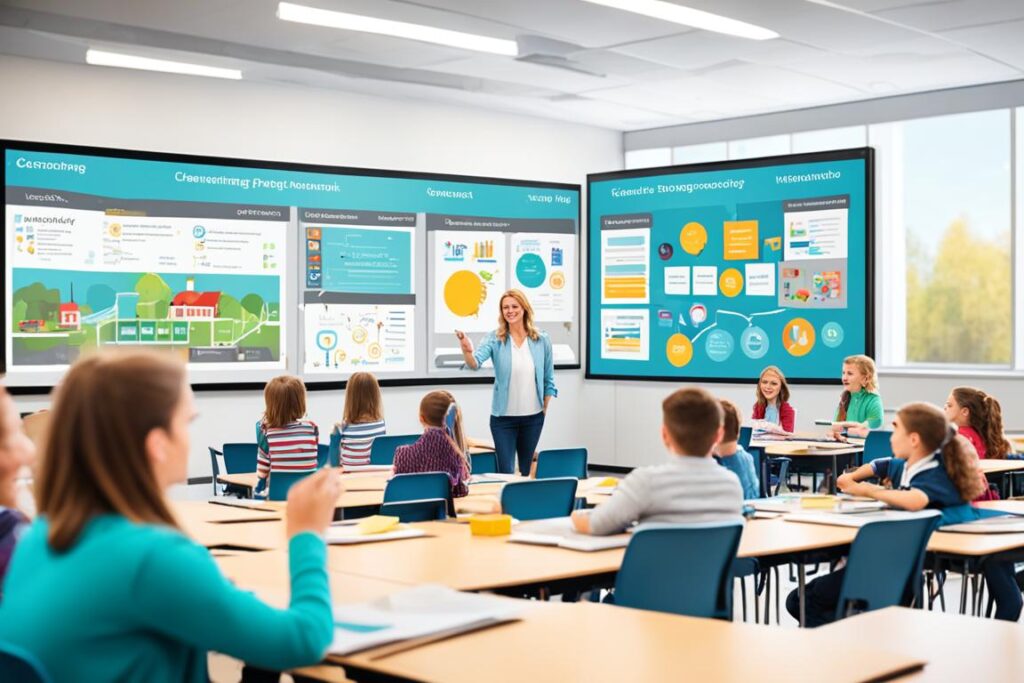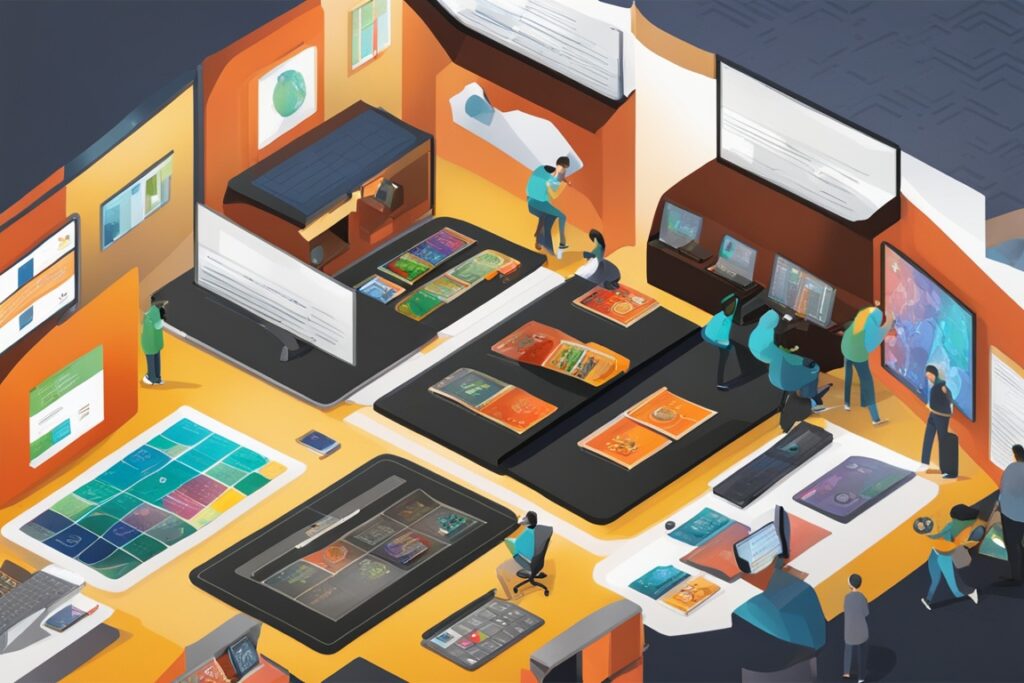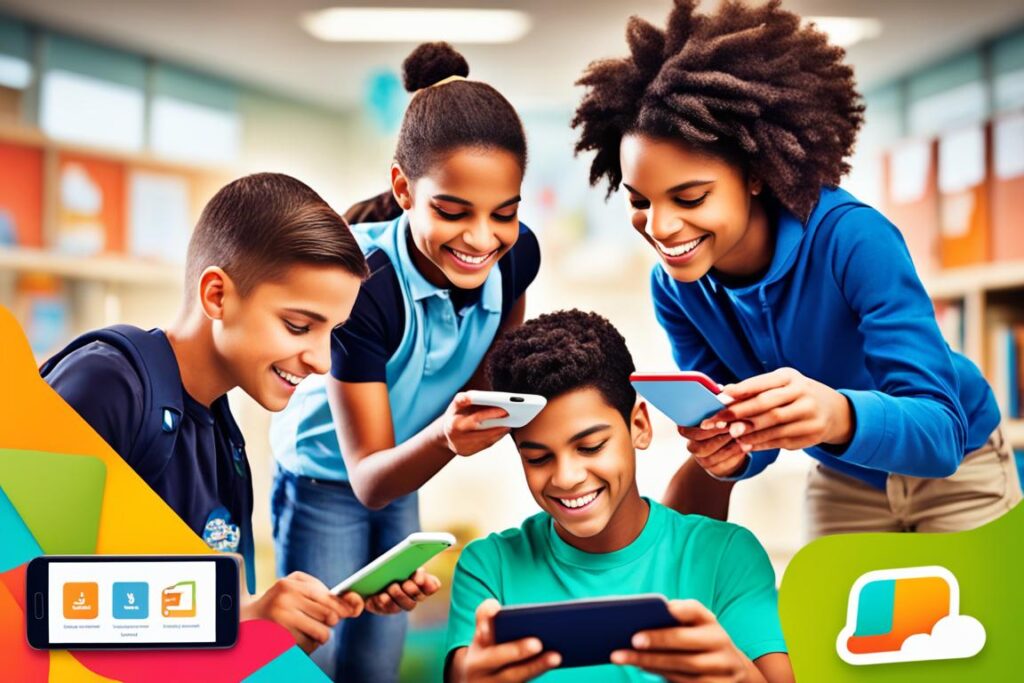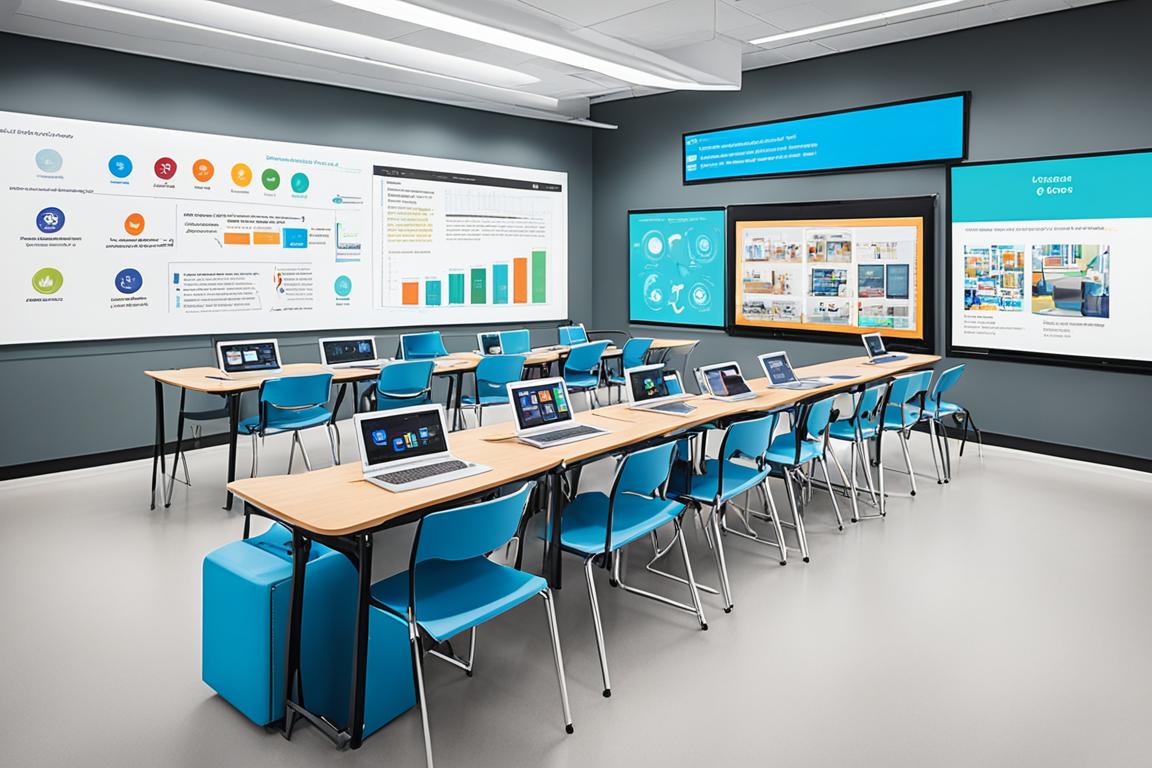The future of education is bright with new tech. The recent Future of Education Technology Conference in New Orleans showed off advanced solutions. They’re ready to change how we learn.1 Big names like AVer Information, BenQ, and others showcased top-tier products. These are set to boost student involvement, shape learning to fit every student, encourage working together, and support teachers.
These new tools understand what we need in today’s schools. They range from virtual tutors that use AI to internet that covers every corner for learning from afar. There are also virtual reality worlds and learning software that adjusts to how every student learns.1 This mix of technologies makes it clear: we need tech to make learning more personal, fun, and effective.
Key Takeaways
- Innovative education technology solutions are transforming the classroom experience, addressing the evolving needs of modern education.
- AI-powered virtual tutoring, cloud-based connectivity for remote learning, and immersive virtual reality experiences are redefining the learning landscape.
- Adaptive learning platforms and data-driven insights empower educators to personalize instruction and deliver more effective teaching.
- Collaborative tools and interactive features enhance student engagement, fostering a more dynamic and interactive learning environment.
- The integration of cutting-edge education technology is crucial for driving improvements in productivity, learning outcomes, and 21st-century skills development.
The Evolution of Educational Technology
The history of educational technology is a fascinating story filled with game-changing findings. These have reshaped how we both teach and learn.2 During the 1800s, correspondence courses changed education by letting students far away get their study materials by mail.3 In the 20th century, radio and TV brought educational shows into homes. But, they didn’t offer the back-and-forth like a real classroom.
Historical Perspective
The end of the 20th century saw the birth of the internet. It brought online classes, virtual schooling, and learning that crossed global borders.3 Big steps like creating the Magic Lantern3, launching the World Wide Web3, and the Osborne 1 Laptop’s debut3 set the stage for this digital education revolution.
Impact of Digital Transformation
The COVID-19 pandemic sped up the digital change in education.2 Lockdowns led schools to go online, fast. All over the world, teachers and students quickly adopted remote learning.2 While tough at first, it showed how adaptable and strong the education world is.2 It also highlighted the value of using technology in teaching. Now, education’s future blends online and in-person methods for the best learning.
Adding technology to education has been a slow process. Over the years, new tech like chalkboards3 and ballpoint pens3 changed how we learn.3 The increase in students at all levels made it clear: we need new ways to teach them.
The era of digital learning is only beginning. Soon, there will be AI tutors, learning apps that adapt to you, and virtual reality experiences for school.2 These advanced technologies, along with lessons from the pandemic, will make learning even more exciting and personalized.
The Importance of Innovations in Education Technology
Technology is changing how we learn, as shown in recent studies.4 It’s not just about the classroom anymore. Technology is key to engaging students, making tasks easier, and boosting results.4
Virtual classrooms and interactive boards are making learning fun.5 They also help students work together better. Technology also helps teachers save time on paperwork, letting them focus more on guiding students.4
New ways of learning, like personalized platforms, are making a big difference.5 They use data to give each student what they need. This approach helps every student learn at their best.4

Educational technology is more important than ever.4 It helps teachers build better, more interactive classes. These new methods can really help all students succeed.5
Enhancing Classroom Engagement
Interactive Whiteboards
Interactive whiteboards play a big role in online learning, as the third source explains. Tools like Jamboard and Miro make teaching interactive. They let teachers draw, write, and share videos, just like using traditional boards.
What’s cool is that students can also join in on these digital whiteboards. They become a space for everyone to work together. This helps make learning fun and keeps students involved.6
Virtual and Augmented Reality
Eduverse, from ClassVR/Avantis World, is talked about in the first source. It’s an online world made for schools, where teachers and students can visit new places without leaving the classroom. In Eduverse, the learning setting is interactive and feels real.
This kind of tech opens up a world of possibilities. It turns learning into an adventure where students can work together in amazing virtual scenes.7
Gamification in Learning
Beanstack is introduced in the first source, offering a fun way to get kids reading more. It’s a platform that schools and libraries can use to organize reading events and challenges. These events are designed to make reading fun and rewarding.
Through Beanstack, students can track their reading progress like in a game. This adds an element of fun and helps them enjoy learning.7
Personalized and Adaptive Learning
Artificial intelligence in education is changing how we learn. FEV Tutor, in their studies, showed how virtual tutoring can make a big impact. They help schools pick the best programs. Leaders like Lisa Wills from Ector County are using AI-powered technology to boost student learning and help solve learning gaps. These tools offer customized lessons, meeting each student’s needs, which makes learning more effective.8
Artificial Intelligence in Education
Adaptive learning platforms are key in the education world today. They use tech to tailor learning for every student. This means the content, pace, and feedback fit each learner perfectly. Adaptive learning platforms look at data and use AI to see how well students are doing. Then, they tweak their learning plan to help each student succeed.8

Adaptive Learning Platforms
Technology-enabled personalization is changing education for the better. Adaptive learning platforms create unique learning paths for each student. They look at what students know, what they need, and how they like to learn. This helps students learn at their own speed and reach their top potential.8 These platforms use artificial intelligence and machine learning algorithms to match the learning with the student. They keep a close watch on how students are doing. Plus, they give teachers helpful information and stats. By always adjusting to what each student needs, adaptive learning platforms make sure every student has what they need to succeed in school.8
Collaborative and Immersive Experiences
The third source talks about virtual classrooms in online education. Platforms like Zoom and Microsoft Teams make this possible. They come with video conferencing, screen sharing, and breakout rooms. This way, educators can host live sessions.
Students can take part, ask questions, and join discussions.9 The goal is to make online learning feel like the real thing, creating a sense of community. This encourages everyone to collaborate.
LanSchool Air by Lenovo has introduced a new feature called Co-teaching. This feature lets teachers bring in other education professionals. This includes paraprofessionals, counselors, and school administrators. It makes learning experiences more unified and collaborative.
In the era of digital learning, tools that encourage collaboration are a must. They allow students to team up on projects, share thoughts, and learn from one another. Even though they might be miles apart, they can still work together.
Data-Driven Insights and Analytics
Data-driven analytics are revolutionizing education, enabling teachers to tailor learning better. This approach is growing quickly, helping to pinpoint learning gaps and boost student motivation.10
Learning Analytics
Teachers now use learning analytics to create personalized plans. It improves teaching methods by identifying what works best and tracking student progress.10 This method sharpens digital tools and cuts out what’s not needed, making learning more efficient.10
Educational Analytics Platforms
New technology is changing how data is used in education, making analysis more accurate and quick. Systems like ERP and LMS offer key insights, while AI helps tailor learning for each student.10
By analyzing data, teachers can quickly see what works for students, refining their methods. This insight is vital for ongoing improvement in education, ensuring the best outcomes for everyone.10
The Global EdTech & Smart Classroom Market is set to hit USD 333,327.91 million by 2027. This is a big jump from the USD 102,166.79 million in 2021, showing solid growth. The Americas, Europe, Middle East, and Africa are all eagerly adopting new tech, with market growth rates to match.11
EdTech is using analytics to improve teaching, bridge learning gaps, and measure interventions’ success. By combining AI and machine learning, the field is offering more personal learning. Institutions track student progress and create engaging content for better learning.11 This approach is streamlining educational tech, focusing on student needs and promoting innovation in learning.11
Innovations in Education Technology
The newest education technology changes how we learn and teach. At a conference in New Orleans, experts discussed groundbreaking tools. These transformative tech tools are making big waves in schools.12
The conference highlighted exciting tech. For example, we saw AI-powered learning and wireless access for off-site lessons. There were also innovative tools for managing classrooms better. The goal is to make learning more fun, personal, and effective.12
Big names like Google and Facebook-backed Oculus are pushing VR forward for education. They’re not alone. AI and machine learning are helping in tests, feedback, and custom lessons too.12
Then, there’s12 cloud tech, which helps you study from anywhere. Also, makes it easier to see hard topics and create real models. Let’s not forget how social media connects students all over the world for sharing ideas.12
Now, even faces, fingerprints, and voices can help run schools better. These high-tech systems improve order and how well things run at school. The transformative tech tools truly change the learning game for everyone.12
Transforming Curriculum and Content Delivery
The education world is changing fast, thanks to technology. It’s making learning easier, more fun, and tailored for students. Things like digital textbooks and open educational resources are now common. E-learning platforms and online courses are rising fast. These new tools are shaping the way we learn.
Digital Textbooks and Open Educational Resources
Learning.com bought Codesters to get better at teaching digital content online.13 This buy helps Learning.com offer a full range of digital and computer science lessons for schools. Now, students find it easier and more fun to learn.
E-Learning Platforms and Online Courses
Distance learning has come a long way, from sending lessons by mail to today’s e-learning platforms and online courses. Now, anyone can learn, no matter where they live. They can earn degrees without going to a campus. Features like video calls, tests online, and personal lesson plans make learning online better.

Empowering Educators
Teaching teachers to use educational technology well is key. It changes how students learn in class.14 Almost all teachers see tech as a must for school success. But, many feel they don’t know enough about using it.14 To help, LG Business Solutions and others offer training. They show teachers how to use new gadgets like LG’s CreateBoard.
Professional Development and Training
Helping teachers learn about tech is important for great lessons. More than 90% say they need training for tech in their classes.14 But some feel left out, with about a third upset at the lack of help from schools.14 Schools can do better by giving teachers workshops and resources. This makes them feel ready to use tech in teaching.
15 EdTech training aims to boost your tech skills. This helps teachers use gadgets well in class.15 These programs also let teachers work together. They share what works best. It’s all about getting better and coming up with new ideas.
Educational Technology Integration Strategies
Using tech wisely in lesson planning boosts how much students get involved. It lets teachers try new ideas that use tech well.16 A study once found that good tech use can get kids more excited about learning, but it must fit what they’re learning.
16 Frameworks like SAMR and TPACK can help. They show teachers how to use tech at different levels. That way, it matches what they teach and boosts the learning experience.
Accessibility and Equity in Education
Making sure everyone can use tech and learn well is super important now. Things like mobile learning apps and assistive technologies help a lot. They make learning easier for all students, no matter where they come from or what they need.
Mobile Learning Apps
Kajeet has come up with a cool idea called Kajeet Private Wireless. It’s a special way of connecting to the internet, made just for students. It helps kids in places with no good internet get online. This way, they can use mobile learning apps on different devices more easily.17
Assistive Technologies
Impero has a new safety tool for students, along with Backdrop’s free tools for keeping them safe online and offline. This combo helps schools look out for all students, even those with special needs or disabilities. It’s a big step towards making sure everyone has a fair chance at learning.17

The Future of Educational Technology
Emerging Trends and Innovations
The way we learn is changing fast. Tomorrow’s education will be big on digital tools and tailored to each student.18 With the rise of AI in teaching and technologies like virtual and augmented reality, learning is already becoming more dynamic and fun for everyone.18 Tools like ChatGPT show us that these changes are just the beginning18.
Challenges and Opportunities
Switching to tech-heavy learning has not been easy. It required teachers and students to quickly find their way around new tools. Students needed more self-discipline, and teachers had to leave old teaching methods behind. But the pandemic also showed us how flexible education can be. It opened doors to new ways of learning that mix the best of both traditional and online.
The18 ESSER funding, which ends in 2024, helped a lot. It gave schools money to invest in tech. This supported the quick adoption of new tools by students and teachers.18 The use of VR, AR, and MR in classrooms is growing, thanks to new devices.18 Plus, gamification is making learning more fun and engaging for students.18
Tech is deeply changing education. Yet, it raises concerns about student data security. Especially after the increase in cyberattacks on schools.18 Experts highlight the importance of using data wisely. They say it must be used to make lessons better for each student. This ensures that technology truly helps students in every way.18
The future of learning is bright. By19 2050, almost everyone could be learning online.19 The market for educational games is also set to grow hugely.19 This shows the growing importance of interactive learning.19
These tech changes can make learning great for all students. Navigating challenges and grabbing opportunities is key. It will help make learning fair, personal, and effective for everyone.18
Conclusion
Educational technology has changed how we learn. From old mail courses to modern digital classrooms, innovations in education technology are more important than ever. They make learning more personal, engaging, and include everyone. These tools help teachers understand students better, making education stronger.20
The future of education lies in new tech. It needs to be smooth and make learning better for all. There are challenges, but they have shown us new ways to teach. This will lead to a stronger, more flexible system where tech and teaching meet well. Together, they will help every student reach their true potential.2122
Educational technology is vital for the learning world. It makes learning more personal and lets students and teachers work together better. The data it provides helps students succeed. Moving ahead, these new techs will play a big part in how we learn. They will make sure every student has a great and fair chance to learn.21
FAQ
What are some of the latest innovations in education technology showcased at the Future of Education Technology Conference?
How has the evolution of educational technology impacted the way students learn and teachers instruct?
What are the key benefits of integrating technology in the classroom?
How do interactive whiteboards enhance the online learning experience?
What are the key features of adaptive learning platforms, and how do they benefit students?
How do virtual classrooms and online collaboration tools enhance the digital learning experience?
How can learning analytics and educational analytics platforms help improve the overall educational experience?
What are some of the other innovative technologies and solutions showcased at the Future of Education Technology Conference?
How are companies like Learning.com and LG Business Solutions helping to transform curriculum and content delivery, as well as support educators in effectively utilizing educational technology?
How are companies like Kajeet and Impero addressing the issues of accessibility and equity in education?
Source Links
- https://www.edelements.com/technology-in-classroom
- https://online.purdue.edu/blog/education/evolution-technology-classroom
- https://edtechmagazine.com/k12/article/2022/01/evolution-technology-k-12-classrooms-1659-today-perfcon
- https://marketscale.com/industries/education-technology/educational-technology-innovations-beyond-classroom-walls/
- https://corp.kaltura.com/blog/what-is-innovation-in-education/
- https://drexel.edu/soe/resources/student-teaching/advice/how-to-use-technology-in-the-classroom/
- https://www.edutopia.org/article/using-technology-support-student-engagement/
- https://www.straive.com/blogs/the-power-of-personalization-how-adaptive-learning-systems-are-changing-the-education-landscape
- https://www.eschoolnews.com/it-leadership/2023/12/11/k-12-tech-innovation-news/
- https://blog.allviaedu.com/educator/12894/
- https://us.sganalytics.com/blog/data-analytics-trend-in-edtech-industry
- https://www.theamegroup.com/top-6-technology-innovations-education/
- https://www.phoenix.edu/online-education-certificates/educational-technology-post-masters.html
- https://iste.org/blog/empowering-teachers-to-implement-technology-driven-educational-programs
- https://medium.com/@ahmad_alrazni/empowering-educators-the-key-to-successful-edtech-integration-ea3de4da3a9b
- https://www.worldbank.org/en/topic/edutech/brief/empower-reachers-reimagining-human-connections-technology-and-innovation-in-education-at-the-world-bank
- https://www.goguardian.com/blog/equitable-access-to-technology
- https://news.stanford.edu/stories/2024/02/technology-in-education
- https://www.educate-me.co/blog/future-of-education-technology
- https://www.thepolicycircle.org/brief/innovation/
- https://www.eschoolnews.com/it-leadership/2023/12/11/the-impact-of-technology-on-education/
- https://www.educause.edu/ecar/research-publications/ecar-study-of-undergraduate-students-and-information-technology/2018/conclusion-and-recommendations
